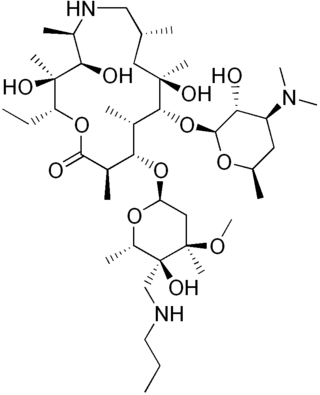
A veterinarian (vet), also known as a veterinary surgeon or veterinary physician, is a medical professional who practices veterinary medicine. They manage a wide range of health conditions and injuries in non-human animals. Along with this, vets also play a role in animal reproduction, animal health management, conservation, husbandry and breeding and preventive medicine like animal nutrition, vaccination and parasitic control as well as biosecurity and zoonotic disease surveillance and prevention.

Abamectin is a widely used insecticide and anthelmintic. Abamectin, is a member of the Avermectin family and is a natural fermentation product of soil dwelling actinomycete Streptomyces avermitilis. Abamectin, differs from Ivermectin, the popular member of the Avermectin family, by double bond on C-22-25. Fermentation of Streptomyces avermitilis yields 8 closely related Avermectin homologues out of which B1 forms the bulk of the fermentation. The non proprietary name, abamectin, is a combination of Bla and B1b. Out of all the Avermectins, abamectin is the only one that is used both in agriculture and pharmaceuticals.

Ivermectin is an antiparasitic drug. After its discovery in 1975, its first uses were in veterinary medicine to prevent and treat heartworm and acariasis. Approved for human use in 1987, today it is used to treat infestations including head lice, scabies, river blindness (onchocerciasis), strongyloidiasis, trichuriasis, ascariasis and lymphatic filariasis. It works through many mechanisms to kill the targeted parasites, and can be taken orally, or applied to the skin for external infestations. It belongs to the avermectin family of medications.

Haemonchus contortus, also known as the barber's pole worm, is a very common parasite and one of the most pathogenic nematodes of ruminants. Adult worms attach to abomasal mucosa and feed on the blood. This parasite is responsible for anemia, oedema, and death of infected sheep and goats, mainly during summer in warm, humid climates.

Moxidectin is an anthelmintic drug used in animals to prevent or control parasitic worms (helminths), such as heartworm and intestinal worms, in dogs, cats, horses, cattle and sheep. Moxidectin kills some of the most common internal and external parasites by selectively binding to a parasite's glutamate-gated chloride ion channels. These channels are vital to the function of invertebrate nerve and muscle cells; when moxidectin binds to the channels, it disrupts neurotransmission, resulting in paralysis and death of the parasite.

Parasitic bronchitis, also known as hoose, husk, or verminous bronchitis, is a disease of sheep, cattle, goats, and swine caused by the presence of various species of parasite, commonly known as lungworms, in the bronchial tubes or in the lungs. It is marked by cough, dyspnea, anorexia and constipation. Lungworms which cause parasitic bronchitis include nematodes of the genera Dictyocaulus, Metastrongylus, and Protostrongylus. Hoose is essentially an infantile disease, almost always afflicting animals under one year of age.

Levamisole, sold under the brand name Ergamisol among others, is a medication used to treat parasitic worm infections, specifically ascariasis and hookworm infections. It is taken by mouth.

Fenbendazole is a broad spectrum benzimidazole anthelmintic used against gastrointestinal parasites including: giardia, roundworms, hookworms, whipworms, the tapeworm genus Taenia, pinworms, aelurostrongylus, paragonimiasis, strongyles, and strongyloides that can be administered to sheep, cattle, horses, fish, dogs, cats, rabbits, most reptiles, freshwater shrimp tanks as planaria and hydra treatments, as well as seals.

Ethnoveterinary medicine (EVM) considers that traditional practices of veterinary medicine are legitimate and seeks to validate them. Many non-Western traditions of veterinary medicine exist, such as acupuncture and herbal medicine in China, Tibetan veterinary medicine, Ayurveda in India, etc. These traditions have written records that go back thousands of years, for example the Jewish sources in the Old Testament and Talmud and the Sri Lankan 400-year-old palm-leaf frond records of veterinary treatments. Since colonial times scientists had always taken note of indigenous knowledge of animal health and diagnostic skills before implementing their Western-technology projects.

Hugh McLeod Gordon, was a pioneering Australian veterinary scientist and parasitologist.
Alternative veterinary medicine is the use of alternative medicine in the treatment of animals. Types alternative therapies used for veterinary treatments may include, but are not limited to, acupuncture, herbal medicine, homeopathy, ethnomedicine and chiropractic. The term includes many treatments that don't have enough evidence to support them being a standard method within many veterinary practices.

Tulathromycin, sold under the brand name Draxxin and the top generic is branded under the name Tulieve,from Norbrook Ltd., is a macrolide antibiotic used to treat bovine respiratory disease (BRD) in cattle and swine respiratory disease in pigs.

Anthelmintics or antihelminthics are a group of antiparasitic drugs that expel parasitic worms (helminths) and other internal parasites from the body by either stunning or killing them and without causing significant damage to the host. They may also be called vermifuges or vermicides. Anthelmintics are used to treat people who are infected by helminths, a condition called helminthiasis. These drugs are also used to treat infected animals.

Nitroscanate is an anthelmintic drug used in veterinary medicine to treat Toxocara canis, Toxascaris leonina, Ancylostoma caninum, Uncinaria stenocephala, Taenia, and Dipylidium caninum.
Ostertagia ostertagi, commonly known as the medium stomach worm or brown stomach worm, is a parasitic nematode of cattle. O. ostertagi can also be found to a lesser extent in sheep, goats, wild ruminants, and horses. It causes ostertagiosis, which is potentially fatal in cattle. It is found worldwide and is economically important to cattle industries, particularly those found in temperate climates.
The fecal egg count reduction test was suggested in the World Association for the Advancement of Veterinary Parasitology guideline for estimating the reduction in fecal egg counts and its corresponding confidence interval. The results of this test can be used to determine the anthelmintic resistance status of the animals.

Morantel is an anthelmintic drug used for the removal of parasitic worms in livestock. It affects the nervous system of worms given the drug is an inhibitor of acetylcholinesterase. It is derived in part from 3-methylthiophene. Morantel is closely related to pyrantel.

Nitroxinil is an anthelmintic, a veterinary medicine against parasitic worms in sheep and cattle. The substance is active against the liver fluke the Fasciola hepatica and to a lesser extent against thread worms in the gastrointestinal tract. Brand names include Fluconix, Dovenix and Trodax. Nitroxynil is also used against strains of the red gum worm that have become resistant to benzimidazoles.

Cooperia is a genus of nematode from the Cooperiidae family that is one of the most common intestinal parasitic nematodes in cattle in temperate regions. Infections with Cooperia may result in mild clinical symptoms, but can lead to weight loss and damage of the small intestine, especially when co-infections with other nematodes such as Ostertagia ostertagi occur. Infections are usually treated with broad-spectrum anthelmintics such as benzimidazole, but resistance to these drugs has developed in the last decades and is now very common. Cooperia has a direct life cycle. Infective larvae are ingested by the host. The larvae grow to adults, which reproduce in the small intestines. Eggs are shed onto the pasture with the faeces, which leads to new infections. Co-infections with other gastro-intestinal nematodes such as O. ostertagi and Haemonchus contortus are common.

Cattle drenching is the process of administrating chemical solutions (anthelmintics) to cattle or Bos taurus with the purpose of protecting livestock from various parasites including worms, fluke, cattle ticks, lice and flies. Parasites hinder the production of cattle through living off their host and carrying diseases that can be transmitted to cattle. Cattle drenches can be applied through a solution poured on the back, throat or an injection. Cattle drenches are predominately necessary for young cattle with weaker immune systems that are susceptible to parasite infestation. Drenching is a common method for controlling parasites in the meat and dairy industries. Drenching cattle improves the health, condition and fertility of cattle leading to increased calving rates, weight gain, hide condition and milk production.

















